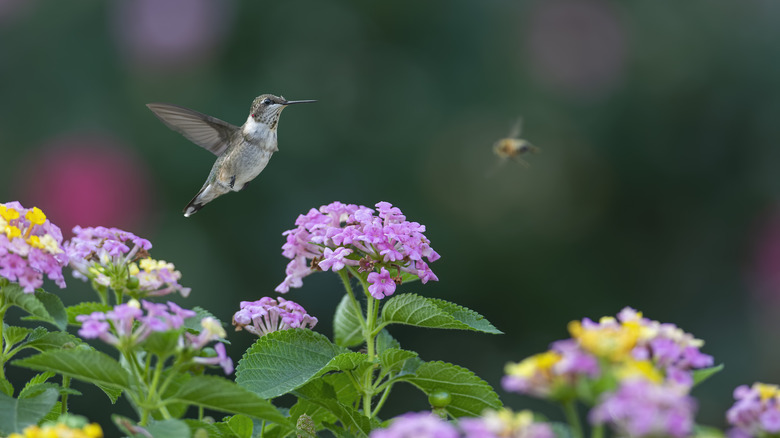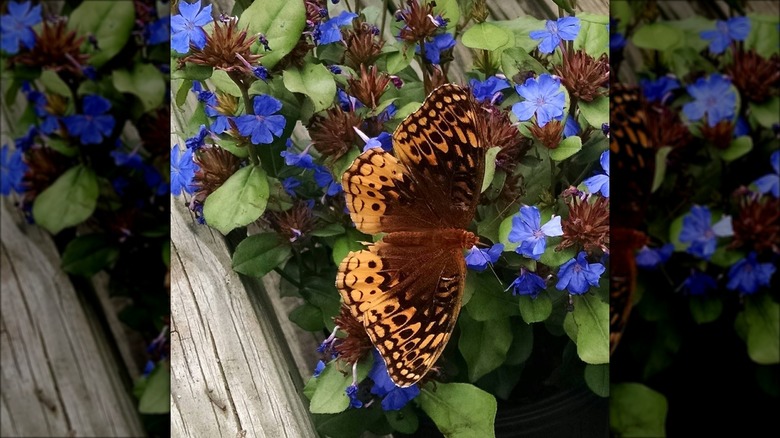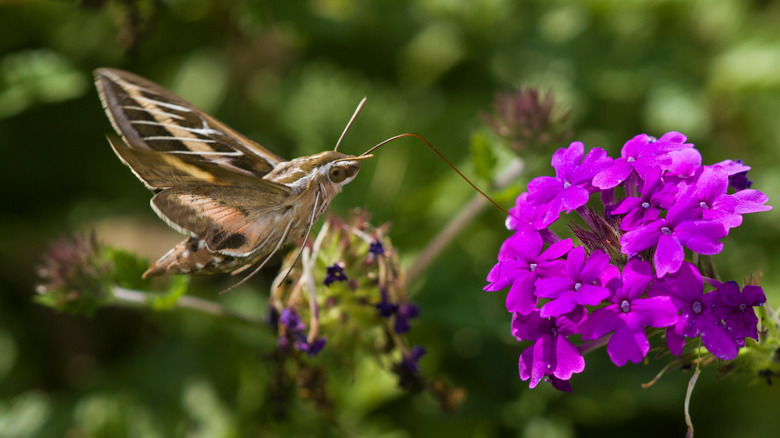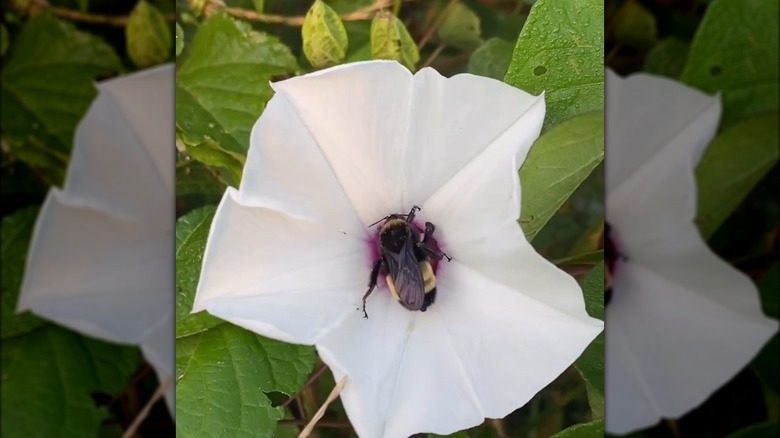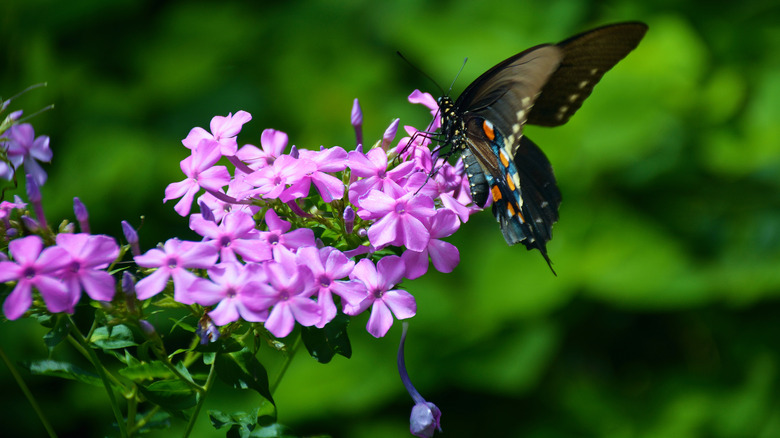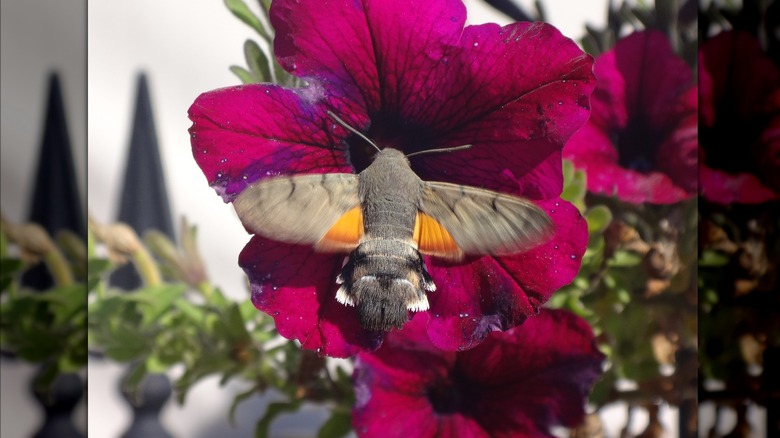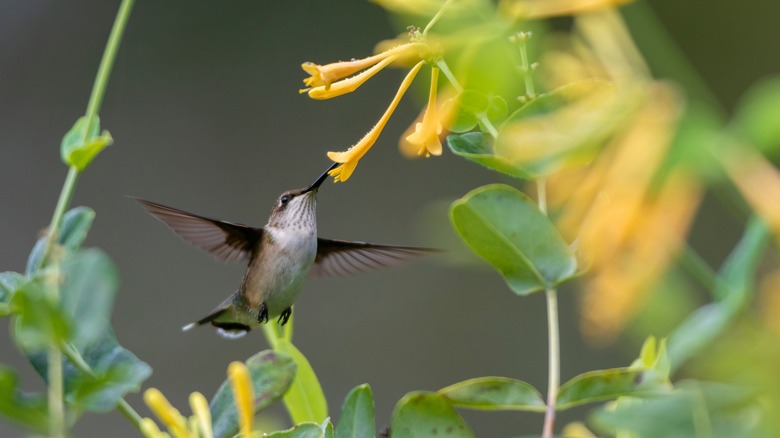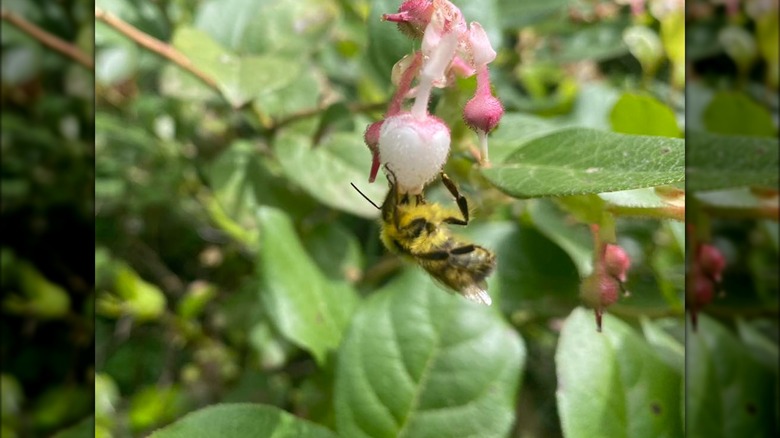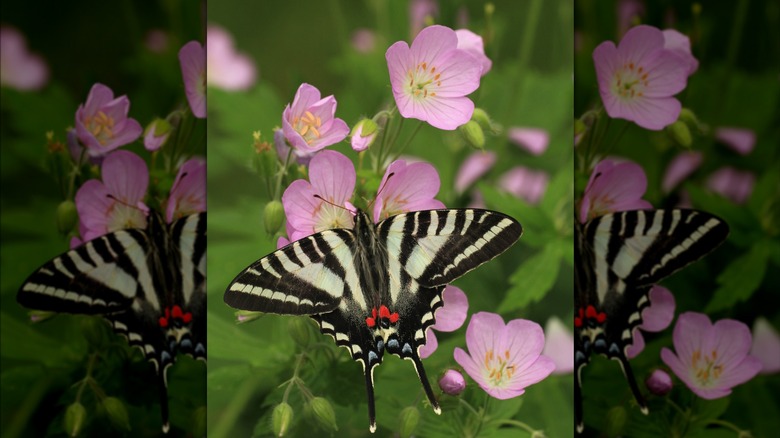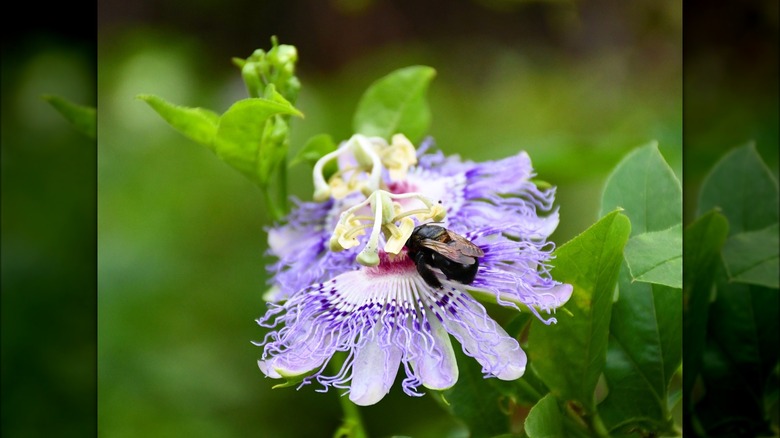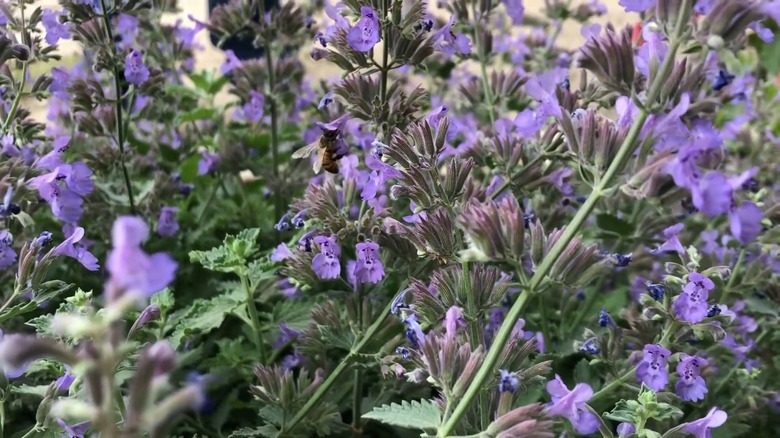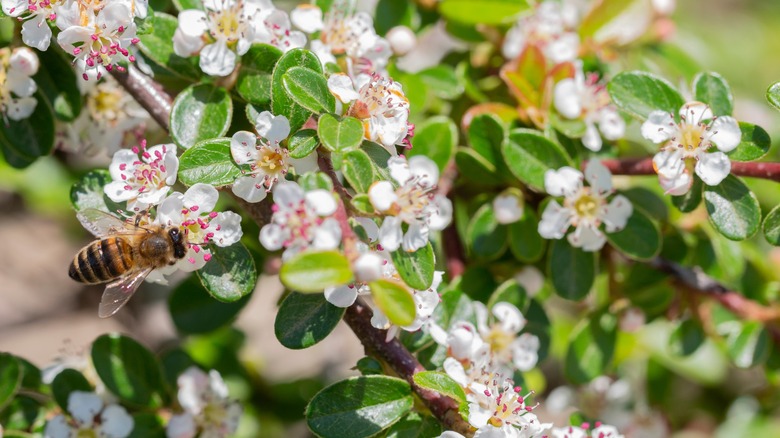Fast-Growing Ground Covers That'll Attract Hummingbirds & Pollinators To Your Yard
Lush, emerald grasses might be the most ubiquitous ground covers across the U.S., and while they're aesthetically pleasing to some, they do little to enhance wildlife value or encourage pollinators. But considering the pivotal role pollinators like bees, beetles, butterflies, songsters, and hummingbirds play in improving plant interactions, ministering and sustaining food production, and stabilizing the environment, it makes sense to take measures to make their lives easier. This is even more prudent when you factor in the damage inflicted on their populations by habitat loss, climate change, and chemical misuse.
While plenty of eco-conscious homeowners have turned to putting out top-rated hummingbird feeders or establishing bee hotels to bring more pollinators into their yards, there's scope for much more, starting right at the ground. Rose verbena, creeping phlox, trumpet honeysuckles, wild geraniums, and other similar low-growing plants and vines serve both as ornamental ground covers and pollinator attractants. Although their fast growth is certainly an advantage since it helps put weeds out of business, controls runoff, and enriches soil while enhancing visual appeal in a short time, it can become counter-intuitive if the covers themselves transmute into weeds by monopolizing adjoining spaces. So, either offset the aggressive growers by combining them with a similarly prolific spreader to keep both in check or keep up with regular maintenance, especially deadheading and physical removal, to control unruly growth.
Perennial plumbago is a pollinator-friendly beauty
Hailing from the rocky foothills of China, perennial plumbago or leadwort (Ceratostigma plumbaginoides) is a gentian, waterwise addition to pollinator gardens. It explodes in tubular, blue flowers midsummer that hummingbirds readily sink their narrow bills in. Butterflies dart in for the nectar, too, when the hummers aren't pugnaciously defending their food source.
Having earned gold from the University of Georgia's commission in 2006, perennial plumbago makes a gorgeous ground cover, topping out at around 10 inches, with some tolerance for foot traffic. Its rapid growth and ability to suppress weeds without turning invasive have made it a popular contender to replace evergreen favorites like the English ivy and vinca, especially in USDA zones 5 through 9. However, its foliage will drop during the winter in colder climates (below zone 9), where it behaves as a deciduous plant.
Perennial plumbago tolerates shade, as is exemplified by its palmy spread under trees and shrubs where most grasses fail, and sometimes prefers it, particularly in the hot summer afternoons down south. It's also a great fit from a maintenance point of view since it's happy in most soils, including clay, provided they don't drain poorly. It earns little traction from pests, with citrus mealybugs being an exception. While rushing to get leadwort seeds or cuttings, don't forget to wear gloves because the ground cover can irritate bare skin.
Rose verbena draws diverse long-tongued pollinators
Although short-lived and sometimes conducting itself as an annual, rose verbena (Verbena canadensis) is a beautiful ground cover addition to extend the time pollinators spend in your garden. By framing their lobed foliage with nectar-rich, lavender or pink flowers from spring through fall, verbenas entertain a bevy of pollen carriers, including mason and bumble bees, skippers, hummingbirds, and plenty of other butterfly species. Sweat and andrenid bees may also reach for their umbels, owing to their past familiarity with the North American native plant, albeit with some struggle. Rose verbenas, or vervains, also garner songbirds' attention with their nutty fruits.
Naturally adaptive, if their endemic presence in rocky hills and roadsides is any indication, rose verbena can be easily planted in shallow, poor soils with decent drainage. They're equally accepting of clay substrates in growth zones 6 through 10. Stretching 2 feet wide, they're quick to establish their roots wherever their stem nodes touch the dirt, outmaneuvering any weeds meaning to take over. The abiotic and Phytophthora rot-resistant cultivar 'Homestead Purple' is particularly enthusiastic. However, in case you find verbenas breaching their boundaries, remember that they're shallow-rooted and can be easily pulled or dug out. Up north, heavy mulching will be necessary during winter, which can become a breeding ground for slugs and snails if not cared for adequately. Deer can pose problems, too. As most horticulturally-sold verbenas are hybrids, don't depend on them naturalizing through self-seeding.
Wild potato vines attract specialized pollinators
Winter hardy in zones 3 to 8, wild potato vine (Ipomoea pandurate) can sprawl and carpet the ground with its purple-tinged, hairy stems adorned by heart-shaped green foliage. When its flowering season kickstarts in the spring, hummingbirds can be seen loitering around the purple-eyed, white flowers, sipping the sweet nectar. Other times, specialized bees, such as mallow and morning glory, are highly active, furthering pollination, with bumble, digger, and honeybees joining in the cocktail party. Well into the fall, you'll also find tortoise and flea beetles, skippers, swallowtails, and mysterious moths visiting the flowers, with some even tracking their roots. Additionally, birds use the densely packed ground cover as their autumn hideout. Luckily, most mammals find the potato vines unappetizing, keeping the herbivory on the down low.
Easily sown with seeds, the eastern U.S. native vines can be grown in most soils, in sun or shade, for an extended flower display in the garden. However, they can become extremely aggressive in moist conditions and warmer states, colonizing the surrounding area, which can be difficult to eliminate due to deep rooting. However, deadheading the spent blooms before they set seeds can prevent wind pollination and associated encroachment. Sweet potato weevils can become problematic for the otherwise pest- and disease-resistant potato vine.
Creeping phlox dazzles both pollinators and thieves
Not to be confused with Phlox subulata, which shares its common name, creeping phlox (Phlox stolonifera) is another popular flowering ground cover that hummingbirds and butterflies love. Like a salver, its five-petaled blooms balance daintily on delicate stems, arranging a fine-dining experience for myriad pollinators, including skippers, moths, monarchs, and hoverflies. To avoid feeling robbed of this opportunity, certain short-mouthed bees may resort to puncturing the whorls for a quick sip and dash away without collecting pollen — although it does add to the insect diversity. Luckily, deer and rabbits show little interest in its under 1-foot-tall mound.
An early spring bloomer, creeping phlox paints the garden in pastel, rosy-lilac, or blue-violet colors. It also soaks it with a sweet fragrance, endearing its growers. Endemic in the Appalachian banks and woods, it flourishes in moist, organically-rich, and acidic soils but will tolerate dry, shallow dirt in rock gardens. It's unbothered by black walnut, drought, and urban pollution and would happily run on slopes through its stolons to curb erosion. However, compared to its other phlox cousins, the creeping species isn't very cold-hardy, limiting its range to USDA zones 5 through 9. Moreover, barring the north, where it requires a fair bit of sun, it aspires to be planted in dappled shade down south. Deadheading is another non-negotiable to keep powdery mildew and self-seeding in check. Cultivars like 'Sherwood Purple,' 'Blue Ridge,' and 'Home Fires' make excellent ground covers.
Garden petunias spread so hummingbirds can rejoice
Beautiful petunia varieties that will keep hummingbirds coming back for more include cascading or trailing species that are quick to establish on the ground while staying a manageable 1.5 feet tall and 3 feet wide. Garden petunias (Petunia x hybrida) have also found traction with butterflies who gravitate to them for the same reason hummers do: the nectar present in the mass of flowers in spectral shades of muted pinks, burgundy reds, haloed yellows, and variegated whites.
Besides, garden petunias are popular for their long blooming season that persists throughout the summer until the frost, even when planted in poor soils or moderate shade. However, to avoid risking the petunias growing long-limbed, you'll be best served to expose them to full sun, top-dress with nitrogen fertilizers mid-season, deadhead faded blooms, and prune the foliage sporadically. In short, some maintenance will be necessary. While garden petunias will return year after year in growth zones 10 to 11, they must be overwintered indoors in other regions. Good drainage is key to successful performance, as the ground cover is susceptible to mold, viruses, petal blight, and root rot. While they don't invite the deer's interest, common garden pests, such as aphids, slugs, and caterpillars may impose significant pressure. Seed-based, disease- and weather-tolerant 'Wave' series, especially 'Shock Wave' and 'Tidal Wave,' perform well as ground covers without demanding summer cutbacks. 'Avalanche' series works, too.
Trumpet honeysuckle is your ticket to a pollinator haven
Allowing trumpet honeysuckle (Lonicera sempervirens) to stretch unsupported on the garden soil is a sustainable approach to attracting hummingbirds and pollinators, particularly in their native southeast U.S. range. The hovering ruby-throated birds, in addition to a bunch of honey, carpenter, and green metallic bees, naturally pivot toward the nectar founts, and spring azure butterflies and snowberry clearwing moths strive for a place on the foliage to rear their larvae. You'll also find a couple of gold and purple finches, quails, and robins scanning the honeysuckle vines for fruits in the fall or diving in it for safety when your cat is roaming about.
To make the best of the stalwart vine, ensure it gets a spot in the sunniest part of your zone 4 through 9 gardens. That's because the greater the sun exposure, the more effusively the ground cover blooms. But if that's hard to come by, plop the cuttings (or seeds) in slightly acidic, organically-rich, moist soils receiving over two hours of sunlight — avoid sandy substrates at all costs. Coastal gardeners, black walnut tree growers, and compacted soil owners will find trumpet honeysuckles will survive in their complicated terrain with little complaints. However, keep the 6-foot-wide woody perennial away from your home's foundation and walls, as it's an easy conduit for fire. You might also want to keep an eye out for aphids, leaf rollers, and powdery mildew in overcrowded covers.
Salal has the heart of pollinators
Widespread in the Pacific Northwest's forest trails, salal (Gaultheria shallon), or Oregon wintergreen, has — ever since its discovery — become an evergreen staple in floral arrangements and a native must-have in home gardens. Hummingbirds, brown elfin butterflies, bees, beneficial insects, and other miscellaneous pollinators find the shrub's pinkish-white flowers irresistible, given that they're brimming with sugary syrup. Its burgundy or copper stems pack into thickets, providing a windshield and cover to songbirds and mammals when they aren't busy nibbling on summer berries or browsing the leathery foliage.
As the 1-foot-high shrub ambles all over the place by sending out stolons, it works brilliantly as a ground cover, spreading as far and wide as the space allows. However, you can easily pull the runners out as they root superficially or keep the shrub trimmed to put a lid on its intrusive nature. To achieve quick coverage, you'll have to start salal with cuttings or layering because their seeds are slow to germinate. Winter hardy in USDA zones 5 through 9, they are particularly handy in sun-masked areas or as conifer understories, given their love for deep shade. However, if pushed, they will accept direct sun, but be prepared for some leaf scorching.
Pollinators of all stripes and sizes visit wild geranium
Another mesic forest find, wild geranium (Geranium maculatum), deserves a spot in your garden if you've got a black thumb. That's because these geranium plants are easy to grow and maintain, complying with most conditions from dappled shade to full sun and clay to sandy soils, making them go-to flowers that even the worst gardeners can handle. When wild geraniums explode in pink or lilac flowers, they not only allude to the spring's crossover to summer, but also attract a stream of eager butterflies, syrphid flies, beneficial bugs, ants, beetles, and specialized bees, including bumble, honey, and solitary. When the umbels fade away to make space for beaked seeds — earning them the moniker of cranesbill — they grab the attention of numerous songbirds. Deer and bunnies may peruse the plant but won't bite.
Fully adapted in growth zones 3 to 11, wild geranium grows just short of 2 feet and similarly wide. However, if your area experiences frequent droughts, you might want to skip the flowering plant as it's quick to grow stressed, chlorotic, and leggy without supplemental irrigation during such times. Wild geraniums are self-sowers when not cut back but are unlikely to invade uncharted territories. They may come under attack from aphids, thrips, froghoppers, and lygus bugs.
Grow Roman chamomile to entice bees and butterflies
Lately popularized as a turfgrass alternative or a filler plant to soften pavers and flagstones, Roman chamomile (Chamaemelum nobile) can also moonlight as a fast-growing ground cover to attract pollinators to your yard. In optimum conditions, it bursts into yellow-eyed, white-rayed, daisy-esque flowers that are visited by bees and butterflies all summer long (at times even during the fall) for the nectar. Plus, your kids will enjoy meandering on the herb patch, given its moderate tolerance for foot traffic. However, ensure you're fully clothed on any such escapades, as a light brush against their evergreen, fern-like leaves may cause skin irritation in some individuals.
Poor soil quality is no problem when growing these beautiful plants as ground covers, though good drainage and a sandy texture are much appreciated. They thrive in full to partial sun exposure in growth zones 4 through 9, extending 12 inches across and half as wide. They aren't vulnerable to any major pests, other than aphids, but are given to infringing upon the rights of surrounding flora when left to their own devices or denied a timely haircut. While 'Treneague' is quite popular as a ground-hugger, it produces no flowers and may offer little pollinator benefits. Instead, look for flowering varieties, like 'Flore Pleno.'
Many pollinators make a beeline for passionflowers
Unlike its cousins from the Passifloraceae family, passionflower vines (Passiflora incarnata) don't depend on arboreal or trellis support to begin producing their purple-crowned, white flowers. They do just fine lounging on and pushing through for more space with their tendrils, gaining new land. When the blooms unfurl in the summer, a swarm of butterflies, carpenter bees, moths, bumble bees, and ruby-throated hummingbirds greet the plant, promising pollination in exchange for the honied syrup. Gulf Fritillary, Zebra Heliconian, Red-banded Hairstreak, and variegated fritillary butterflies may call on the vine whenever they need support for their progeny throughout the year, especially in southern states. However, their uncontrolled foliage consumption may sometimes cost the plant dearly, stunting its growth. Fall may see an influx of songbirds who happily pop their golden eggs, aka berry fruits or maypops, for a sweet meal when other food sources become scant. Luckily, deer aren't much of a problem, but turkeys may snag some juvenile fronds.
Passionflower, also known by various names such as wild passion vine, wild apricot, and maypop, is hardy only up to zone 5. However, it can still be mulched to protect its rhizomes from the winter chill. The drought-resistant ground cover depends on full sun exposure to display its best performance but will adapt to moderate shade. Poor drainage may induce root rot, and nematodes can be a bother. Bear in mind, you'll have to stay on top of deadheading and digging to keep the vine contained.
'Walker's Low' catmint is a pollinator magnet
Don't be fooled by its name, as cats pay little heed to Walker's low catmint (Nepeta x fassenii 'Walker's Low'), just like bunnies and deer. On the other hand, pollinators, such as butterflies, wasps, and hummingbirds, are obsessed with the hybrid cover's purplish-blue flowers that unfurl mid-spring and last through the fall. Mason, honey, bumble, sweat, and leafcutter bees also make it to the botanical show. The best part, though? As its seeds are sterile and it doesn't propagate via rhizomes, choosing to spread from its central crown instead, you don't have to worry about the plant wading into parts where it isn't wanted. 'Walker's Low' is resistant to drought and pollution after it has been established.
To enjoy its silvery foliage, plonk it at a sunny garden site (USDA zones 4 through 8), except in the hot south, where it requires some afternoon cover. Ensure good drainage and high fertility levels for consistent blooming. Spring pruning will keep the ground cover compact and healthy. For new plants, divide the clumps after four years during spring or shear off healthy stems as cuttings in the summer.
Pollinators adore bearberry cotoneaster
Sprouting new stems wherever its roots touch the soil has granted bearberry cotoneaster (Cotoneaster dammeri) immense speed in covering bare sites and fronting the cause of bees, butterflies, and (h)angry birds. Its evergreen foliage cradles a mass of purple-tinged, white flowers that aren't splendid enough to make their growers happy but do a decent job to quench the pollinators' thirst. Fall brings a burnished red touch to the foliage, adding ornamental interest while plumping the birds with red berries that could possibly stay on through the winter if the beaks miss them.
Bearberry cotoneaster is great for water-wise gardens in zones 5 through 8, given its drought and pollution tolerance. It's also suitable on slopes where it sprawls 12 feet wide to prevent runoff. Impoverished soils are no bar either, so long they drain well. Regular trimming keeps the plant neat and contained. Watch for lace bugs, spider mites, and scales. Cotoneasters require some protection in the south during peak summers.
